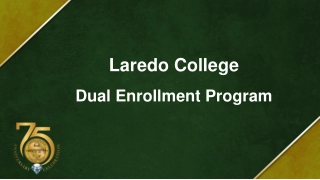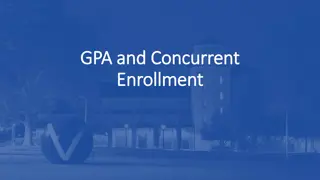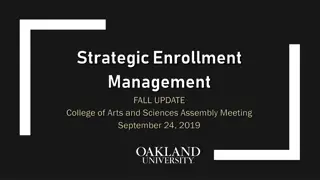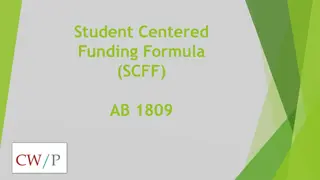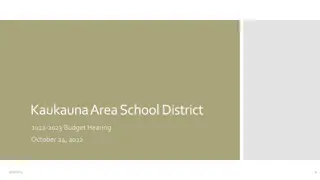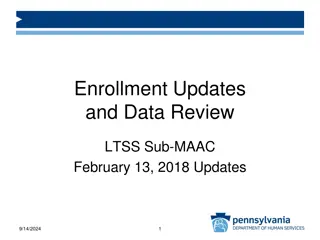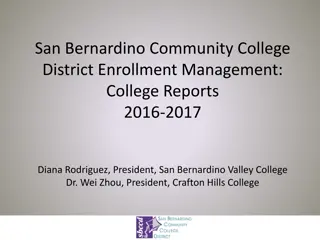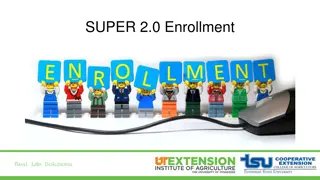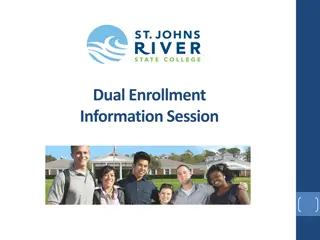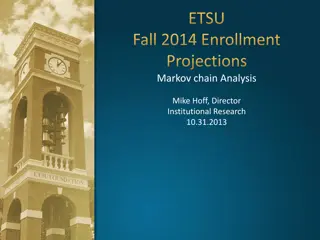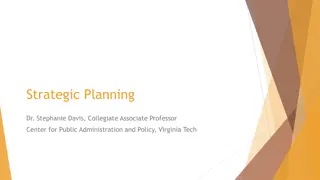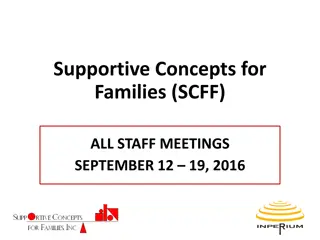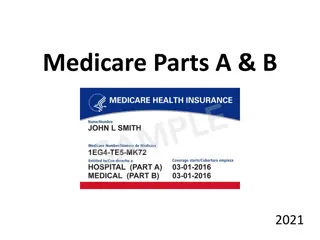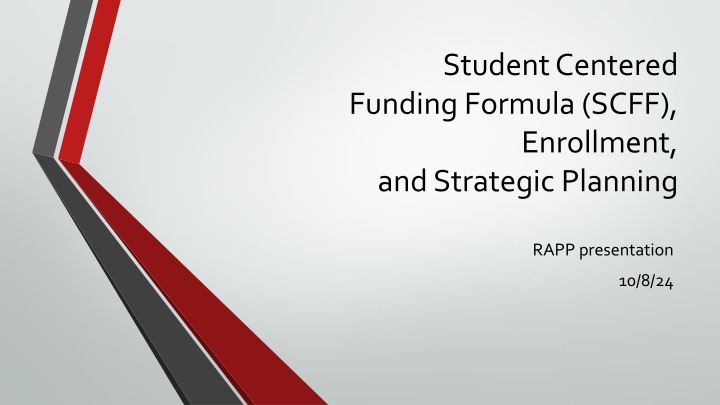
Student-Centered Funding Formula and Strategic Planning
Explore the Student-Centered Funding Formula (SCFF), enrollment strategies, and key aspects of budgeting in educational institutions. Learn about the new funding model emphasizing success, equity, and access, along with base allocations tied to student metrics like FTES and specialized programs. Gain insights into enhancing productivity, FTEF management, and achieving financial sustainability in academic settings.
Download Presentation

Please find below an Image/Link to download the presentation.
The content on the website is provided AS IS for your information and personal use only. It may not be sold, licensed, or shared on other websites without obtaining consent from the author. If you encounter any issues during the download, it is possible that the publisher has removed the file from their server.
You are allowed to download the files provided on this website for personal or commercial use, subject to the condition that they are used lawfully. All files are the property of their respective owners.
The content on the website is provided AS IS for your information and personal use only. It may not be sold, licensed, or shared on other websites without obtaining consent from the author.
E N D
Presentation Transcript
Student Centered Funding Formula (SCFF), Enrollment, and Strategic Planning RAPP presentation 10/8/24
Examples of Types of Budgets Fund 14 General Fund Categorical funding (e.g. Lottery, Instructional Equipment) Grants (Federal, State) Fund 15 (self-sustaining) Foundation (donated) Bond measure
Previous Funding Model (Enrollment focus) Can t go above cap Unfunded FTES unless in growth mode Over cap Growth Cap: Maximum # of students funded by the State FTES Full-Time Equivalent Student FTES: Funding per full- time equivalent student in addition to base ( Base: base apportionment determined by size Below base Can t fall below it or State will rebase apportionment
Productivity, FTEF, and Breaking Even FTEF WSCH per FTEF Target was low 500 s Actual for academic year 2023- 24 was 528 38 students per class 10 productivity pts. = $1M Demands on 1320 dollars Leaves PDL, extended sick Reassigned time FT faculty = General fund PT faculty = 1320 dollars Approx. $10K per class $18M/yr. = 1800 classes/yr. = 450 classes/qtr. Productivity Breaking even
New Funding Model Student-Centered Funding Formula (SCFF) 10% success 20% equity 70% access (base allocation linked mainly to FTES)
New Funding Model Student-Centered Funding Formula (SCFF) Base allocation based on FTES Subject to three-year average (current year + two previous years) Traditional credit students 10% success 20% equity Based on current year actuals CDCP (Career Development and College Preparation/mainly noncredit) Special Admit/dual enrollment Students in correctional facilities 70% access (base allocation)
Base allocation funding per student Amount Credit FTES $ 5,263.20 Credit FTS special admit $ 7,384.71 Credit FTS incarcerated $ 7,345.93 Noncredit FTS $ 4,417.31 CDCP noncredit FTS $ 7,345.93
New Funding Model Student-Centered Funding Formula (SCFF) 10% success Supplemental allocation. Points are given based on low-income students served: Pell Grant AB540 California College Promise Grants 20% equity 70% access (base allocation)
Supplemental allocation funding per student Amount Pell Grant recipients $ 1,238.71 AB540 students $ 1,238.71 California Promise Grant Recipients $ 1,238.71
New Funding Model Student-Centered Funding Formula (SCFF) Student Success Allocation points awarded to meeting Vision for Success outcomes (3 year average): Completion of degrees and certificates (one per year per student) Completion of transfer level math and English within first academic year Transfer to a four-year university Completion of nine or more CTE semester units Attainment of regional living wage 10% success 20% equity 70% access (base allocation)
Student Success allocation per student Associate Degrees for Transfer $ 2,921.68 Associate Degrees $ 2,191.26 Baccalaureate Degrees $ 2,191.26 Credit Certificates $ 1,460.84 Transfer Level Math and English $ 1,460.84 Transfer $ 1,095.63 Nine or More CTE Units $ 730.42 Achieved Regional Living Wage $ 730.42
Hold Harmless Years Funded at 2017-18 levels In effect through 2024-25 The intent of the hold harmless protection is to provide time for those districts to ramp down their budgets to the new SCFF-calculated funding level or find ways to increase the amount they generate through SCFF (such as by enrolling more financially needy students or improving student outcomes) (Legislative Analyst s Office). 2017-18 2018-19 2019-20 2020-21 2021-22 2022-23 2023-24 2024-25 16,760 16,068 15,863 16,053 14,222 13,868 14,668 4,925
TO RESTORE OR NOT TO RESTORE?
Extra funding SCFF Funding Model and FHDA s Situation 2017-18 levels: Current funding level 16,760 enrollment 2023-24: Approximate 5.8% enrollment increase last year 14,668 enrollment Same funding amount 2022-23: Significant enrollment decrease 13,868 enrollment Hypothetical: Enrollment decrease of 10% 12,481 enrollment
RESTORATION ATTEMPT 2023-24 Tried to restore in 2023-24 with $1.8M one-time funding Approx 5.8% enrollment increase Restored 800 FTES from previous year at De Anza Needs to be a District-wide effort 2017-18 2018-19 2019-20 2020-21 2021-22 2022-23 2023-24 2024-25 16,760 16,068 15,863 16,053 14,222 13,868 14,668 4,925
RESTORATION ATTEMPT 2024-25 2017-18 2018-19 2019-20 2020-21 2021-22 2022-23 2023-24 2024-25 16,760 16,068 15,863 16,053 14,222 13,868 14,668 4,925 Continued $1.8M one-time funding Possibly more one-time funding to try to restore Need approximately 1581 FTES district-wide = 7% growth Traditional credit students = 3-yr. average Focus on specialized categories subject NOT subject to 3-yr. average Summer quarter up 11% (approx. 1880 FTES) Possible change in State accounting method 11.67 12.00 factor
Other factors for consideration Fifty Percent Law The Fifty Percent Law (50% Law), as defined in Education Code Section 84362 and California Code of Regulations Section 59200 et seq., requires each district to spend at least half of its current expense of education each fiscal year for salaries and benefits of classroom instructors . Also included are the salaries, benefits, and related expenses of those coordinators, supervisors, departmental chairpersons and their support staff whose duties are directly related to specific instructional activities. Full Time Faculty Obligation (aka 75/25 rule or FON ) Education Code section 87482.6 was enacted in 1988 by the Legislature to recognize and make efforts to address the goal that 75 percent of the hours of credit instruction taught in California Community Colleges be taught by full-time instructors. This has come to be known as the fulltime/part-time faculty ratio. (from the State California Community College website)

